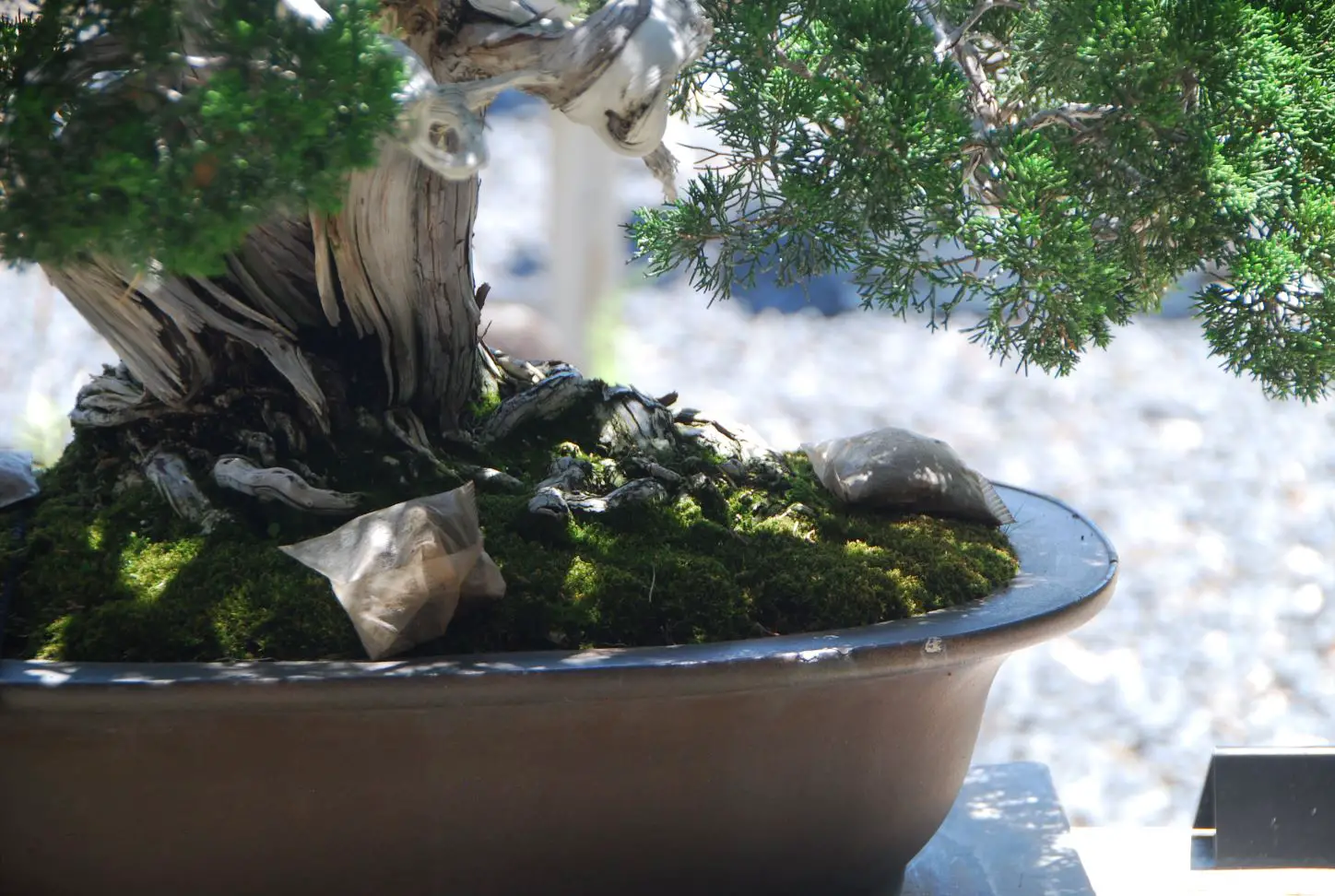When it comes to bonsai fertilizer, you have to make a lot of choices and you might be wondering which one is the best for your bonsai trees.
For bonsai trees, it is recommended to use a slow-release fertilizer with an NPK ratio of 2-1-1 or 4-2-1. Both inorganic and organic options can work well, but solid fertilizers are generally preferred over liquid forms.
What makes fertilizing bonsai trees difficult
Fertilization is a crucial aspect of bonsai tree care, as it helps to ensure the tree’s growth and health. Bonsai trees are miniature versions of larger trees growing in nature. So bonsai trees require the same care and attention as their larger counterparts, including fertilization.
That said, fertilizing bonsai trees is not as easy as it sounds because of their unique growing conditions. Controlling the amount of fertilizers for bonsai trees is one of the challenges you may face with bonsai fertilization.
Risk of under-fertilization
One of the problems is under-fertilization, which is often caused by frequent watering. Bonsai trees require constant irrigation because their soil usually has good drainage and aeration abilities to encourage a healthy root system.
The problem with this, though, is that every time we water bonsai trees, the nutrients in the soil flow out of the pot with it. This means that even if you apply enough fertilizer, any nutrients that are not immediately absorbed can be washed away with irrigation, leading to nutrient deficiency.
This gets even worse when the soil has little or no organic matter, where nutrients are not readily available for bonsai trees. Even when fertilizers are applied, they may be washed away with watering and nutrients may be deficient for their healthy growth.
Also, as bonsai trees grow in small containers, the amount of soil available for the tree’s root system is limited. This means that the tree’s ability to absorb nutrients from the soil is limited in the first place, making it more difficult to control the amount of fertilizer applied.
Risk of over-fertilization
Over-fertilization is the other problem with bonsai fertilization. If you apply too much fertilizer, the roots may suffer from fertilizer burn as the nutrients will not diffuse and be diluted in the soil as they would in nature.
Giving too much fertilizer causes yet another problem. The goal of bonsai cultivation is not to grow large trees but to keep them small and maintain a specific shape. Excessive fertilization in a small pot can lead to elongated branches and overgrown leaves, ruining the shape of the tree.
This is why bonsai fertilization should be done sparingly, to limit growth and maintain the desired shape. Bonsai trees can survive for a year or two without fertilizer as long as they are watered, so it is safer to under-fertilize rather than over-fertilize.
Bonsai tree nutrition needs
Essential nutrients for bonsai trees
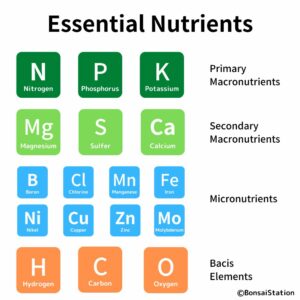
Bonsai trees, like all plants, require specific nutrients to grow and thrive. There are 17 essential nutrients that all plants need to grow. These nutrients are grouped into four categories based on the relative quantity of each nutrient plants need and where plants obtain from:
- primary macronutrients
- secondary macronutrients
- micronutrients, and
- basic elements.
Primary macronutrients
Nitrogen (N), Phosphorus (P), and Potassium (K) are primary macronutrients that plants need in large amounts than other nutrients. These three elements are essential for various aspects of plant growth and development, including the following:
Nitrogen (leafy growth)

Nitrogen (N) is necessary for the formation of chlorophyll, which is essential for photosynthesis. It is the element that promotes green leafy growth and is a big part of making proteins, which are a vital part of all living creatures, including bonsai trees.
This means that nitrogen plays a big role in how fast a plant grows. This is why on the label of fertilizer, the amount of nitrogen (N) is listed as the first number.
Phosphorus (Energy transfer)
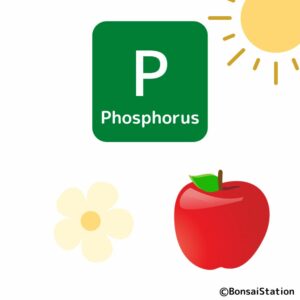
Phosphorus (P) is a key nutrient that helps plants move the energy they make in their leaves to the flowers, fruit, and roots. Phosphorus is thus especially important for plants that are making flowers and fruits. It also helps plants store food in the roots.
Potassium (General health)
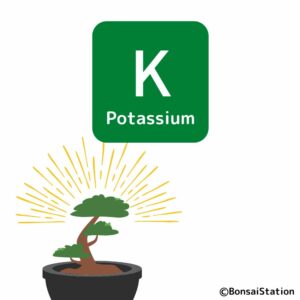
Potassium (K) is necessary for the regulation of respiration and water movement within the plant. It also controls the opening and closing of the plant’s stomata, which are pores on leaves that control respiration.
Adequate potassium fertilization helps plants cope with drought stress, increases disease resistance, and improves cold hardiness.
Secondary macronutrients
Secondary macronutrients include sulfur (S), calcium (Ca), and magnesium (Mg). They are also essential for plant growth and development but are typically needed in much smaller quantities than primary macronutrients.
Sulfur aids in protein formation, calcium helps root and leaf development, and magnesium is a part of chlorophyll and helps with photosynthesis.
Micronutrients
Micronutrients, namely iron, manganese, zinc, copper, boron, molybdenum, chlorine, and nickel, are just as important as macronutrients but are needed in much smaller amounts.
These nutrients play a specific role in plant growth and development such as the production of chlorophyll, the growth and development of buds, flowers and fruits, and the proper functioning of enzymes.
Basic elements

Carbon (C), hydrogen (H), and oxygen (O) are the basic elements that all plants need in the process of photosynthesis, where they convert light energy into chemical energy. These elements are provided through air and water.
If you dried a living plant, about 95% of the plant’s dry weight would be composed of carbon, hydrogen, and oxygen. These elements are thus the foundation of a plant body.
Nutrition need: species
Basic formula
In order to ensure that your bonsai tree receives the proper balance of nutrients, it is important to understand the tree’s fertilization needs. Bonsai trees, like all plants, require a balance of essential nutrients for growth, and the three primary macronutrients play a key role in bonsai trees’ growth and development.
These macronutrients, namely Nitrogen (N), Phosphorus (P), and Potassium (K), are also known as NPK.
Although different species of bonsai have different nutrient needs, they all need leaves to make energy and grow strong. Flowers and fruit for bonsai trees are for humans to admire and not for the survival of the trees.
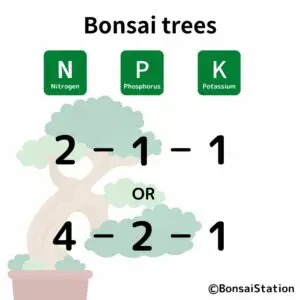
Bonsai Trees NPK ratio
As such, the basic formula for bonsai fertilizer is common for all species, with an NPK ratio of 2-1-1 or 4-2-1, emphasizing the nitrogen ratio for leaf growth.
The latter (4-2-1) coincides with the NPK ratio of traditional bonsai fertilizer, the oil cake. Bonsai oil cake fertilizer is a type of fermented organic fertilizer that is made from the by-product of oilseed extraction, such as canola seeds and soybeans. The oil is extracted from the seeds/beans, leaving behind a protein-rich residue called the “oil cake.”
The bonsai oil cake fertilizer is still actively used and told to be the best fertilizer for bonsai trees among serious bonsai growers in Japan.
Nutrition need: growth stage
The next step is to consider the tree’s growth stage. Bonsai trees go through different growth stages, such as vegetative growth, flowering and fruiting, and dormant stage. Each stage requires different amounts of nutrients (or not), and it’s important to adjust the content of fertilizers accordingly.
Flowering/fruit bonsai trees
Although the basic formula is applicable for all bonsai species, flower and fruit bonsai trees have other nutrient needs for flowering and fruiting, which is phosphorous. Phosphorus is a critical nutrient for flowering and phosphorus deficiencies can cause limited flower development and reduced fruiting.
Potassium is also an extremely important nutrient in bearing fruit because fruit removes a lot of potassium from the soil.
On the other hand, high levels of nitrogen may cause increases in leaf growth instead of floral development. When a plant has enough nitrogen to support its growth, it will focus on growing larger leaves, more branches, and increasing the size of its foliage rather than diverting its resources to reproduction (i.e. flowering and fruiting).
It is thus critical to increase the ratio of phosphorus (P) and potassium (K) and decrease the level of nitrogen (N) in fertilizer when the bonsai trees are developing flower buds (and fruit). It depends on the species, of course, but an N-P-K ratio of 10-10-10 will give balanced growth for most flowering/fruit bonsai trees.
It is worth noting that nitrogen is an important nutrient for floral development and fruit production as well. So, you should not cut nitrogen off completely from the fertilizer for fear of bonsai trees not developing flower buds.
Dormancy
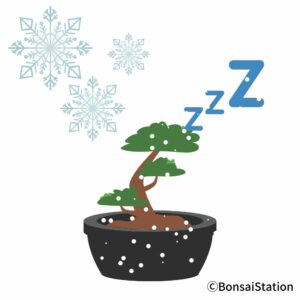
It is recommended to avoid fertilizing bonsai trees during the dormant period.
Deciduous bonsai trees, like other trees, have a dormant period during which they do not grow or produce new leaves. During this period in winter, the trees will use the stored energy and nutrients from the previous growing season to survive.
Evergreen bonsai trees like pines, spruces, and cedars, on the other hand, do not completely go dormant in winter. That said, their growth is nearly absent, although they continue to make energy through photosynthesis.
So, both deciduous and evergreen bonsai species do not need as many nutrients in winter as in the growing season. In addition, giving fertilizers that are rich in nitrogen can wake the trees up and stimulate new growth during winter. A small number of excess nutrients can stress the trees as well.
Best type of fertilizers for bonsai trees
Types of fertilizers
There are several types of fertilizers available for bonsai trees. These can be categorized based on;
- their origin: organic/inorganic,
- their release rate: fast/slow, and
- their form: solid/liquid.
Organic/inorganic fertilizers
Fertilizers can be categorized by their origin, organic or inorganic.
Organic fertilizers
Organic fertilizers are derived from natural sources, such as bone meal, blood meal, and fish emulsion. They are generally considered to be more gentle and are less likely to burn the roots of bonsai trees.
Inorganic fertilizers
Inorganic fertilizers are synthetic fertilizers that are formulated to provide specific nutrient ratios. They are available in many different forms, such as granules, pellets, and liquids.
Fast-acting/slow-release fertilizers
Fertilizers can be categorized by their release rate, fast-acting or slow-release.
Fast-acting
Nutrients of fast-acting fertilizers are readily available for plants when properly placed in soil. Most inorganic (chemical) fertilizers are fast-acting.
Slow-release fertilizers
These are fertilizers that degrade slowly, usually under the influence of soil micro-organisms to release their nutrients over a longer period of time. These are usually organic but slow-release chemical fertilizers (controlled-release) are also available. Controlled-release chemical fertilizers are much more expensive than fast-acting ones.
Solid/liquid
Fertilizers can be categorized by their form, solid/liquid.
Solid
Solid fertilizers are typically granular or in pellets and are less expensive. The difference in the form may lead to a difference in their solubility to water, which can impact their effectiveness and efficiency in feeding trees.
Liquid
Liquid fertilizers are typically dissolved in water, more easily absorbed by plants, and can be applied either to the soil or to leaves.
The best type of fertilizers for bonsai
Among the variety of fertilizers, choosing slow-release fertilizers, preferably in pellets, is crucial for bonsai fertilization.
Both inorganic and organic fertilizers can be used as long as they are slow-release, although most inorganic fertilizers are fast-acting unless they are labeled “slow-release” or “controlled-release”.
And if you are to choose either solid or liquid fertilizers for your bonsai trees, solid fertilizers are better for bonsai trees. The usage of liquid fertilizers should be supplemental.
Why not inorganic and/or liquid fertilizers?
But why should we avoid using fast-acting inorganic and/or liquid fertilizers for bonsai trees? It is because inorganic (liquid) fertilizers are only practical if nutrient leaching or immobilization of nutrients by soil particles is not a serious concern, which is not the case for bonsai trees.
Nutrient leaching
Inorganic, fast-acting (liquid) fertilizers provide quick results but their effects are short-lived. The nutrients can be washed out of the pot with frequent watering and not be fully used by bonsai trees.
Nutrient clogging
Also, these fertilizers release all readily available nutrients in a short period of time after being applied to the soil with moisture. This can cause a sudden concentration of nutrients in the soil, leading to over-fertilization and damage to the tree’s roots.
Why in pellets, not granular?
While granules dissolve faster in water and nutrients are more readily available for trees to absorb, pellets (larger granules) dissolve more slowly and provide a longer-lasting source of nutrients.
One of the disadvantages of granular fertilizers is that when they are scattered over the soil, some part of the nutrients is fixed in the soil, making them unavailable for trees’ uptake. This is because the soil particles can absorb and hold onto the nutrients.
Pellets, on the other hand, are usually placed on the soil, not scattered all over. So, there is minimum contact between the soil and the fertilizer, and thus fixation of nutrients is greatly reduced. In pellets, loss of nitrogen by leaching is reduced and phosphates are better utilized when placed.
Phosphates are insoluble in water and thus “immobile” in the soil. Phosphates cannot be absorbed by roots unless they are close to the roots, like placed directly on top of the soil.
Why is slow-release good for bonsai?
With slow-release fertilizers, nutrient loss is lower and fertilizer-associated risks are minimized. It has the added benefit of reducing the number of fertilizer applications during the growing season.
So, the best kind of fertilizers for bonsai should contain the necessary nutrients and be slow-acting.
Can you use normal fertilizers for bonsai?
You can use any normal fertilizers as long as they have the right NPK value for your bonsai trees.
Bonsai trees require a delicate balance of nutrients to maintain their size and shape. Using a fertilizer that is specifically formulated for bonsai trees may ensure that your tree receives the right balance of nutrients but you have to check the label before you buy. It might not be the case.
It is worth noting that fertilizers formulated for bonsai trees do not contain special nutrients that allow them to grow healthy. They may be formulated in the right balance for bonsai trees and that is all. Note that the “right” balance also depends on the species and growth stage.
How to fertilize bonsai trees
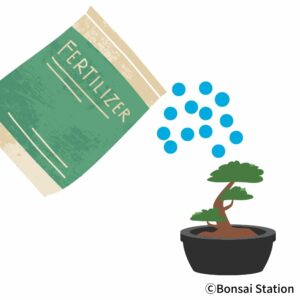
Fertilizing bonsai trees is an important part of their care and proper fertilization should involve the “four R’s” of fertilizer use:
- apply the right type (what kind),
- the right nutrient (content),
- at the right time (when), and
- at the right rate (how much).
The right type
For regular use, slow-release fertilizers are the best choice for bonsai trees because they provide a steady supply of nutrients over an extended period of time, which can help to prevent over-fertilization and the associated problems that come with it.
Organic fertilizers are usually slow-release but inorganic fertilizers labeled “controlled-release” or “slow-release” can also be used.
To supplement additional nutrients for specific needs, such as flowering or thickening the trunk, using diluted liquid fertilizer is a good approach because it can be applied easily and results in faster growth if applied carefully.
The right nutrient
As mentioned in the previous section (“The best type of fertilizer for bonsai trees”), the basic formula for bonsai fertilizer is with an NPK ratio of 2-1-1 or 4-2-1, emphasizing the nitrogen ratio for leaf growth.
For flower and fruit bonsai trees, the NPK ratio of 1-2-1 will give balanced growth when they are developing flower buds.
The right time
When to fertilize
Bonsai trees should be fertilized in spring and fall. Fertilizing in spring to grow (late April to early June) and in fall to develop cold-hardiness (early September to early October) is very important for their health.
The frequency of fertilizing will depend on what particular kind of fertilizer you choose but also on the species of bonsai tree as well. Fertilizing flower and fruit bonsai is tricky because fertilizing at the wrong time may result in less or no flowers and fruits.
Very generally speaking, though, you should apply slow-release organic fertilizers as regular ones every 4 to 6 weeks. Supplemental nutrients should be applied once or twice a month in spring and fall if necessary.
When to avoid fertilizing
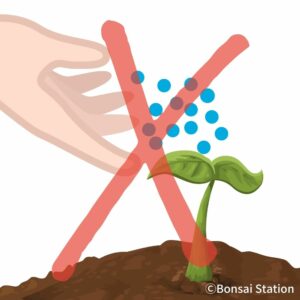
There are times when you should avoid fertilizing:
- During summer and winter;
- Just after repotting until the tree takes roots;
- During flowering;
- (For fruit bonsai) After flowering until the fruits grow to a certain extent;
- After hard wiring until the growth strength is back;
- During an extended period of rain;
- Just after defoliation until new leaves come out.
During these times, bonsai trees are basically stressed for some reason and giving fertilizers do more harm than good.
The right rate
The amount of fertilizing bonsai trees depends on;
- the type of bonsai trees, their age and size, and
- the particular fertilizer you choose.
Bonsai species, age, and size
The amount of fertilizing will depend on the type of bonsai tree, as well as its age and size.
Depending on the natural habitat of the tree, those that grow naturally in fertile soil need a lot of fertilizer, while trees that live in poor soil do not need much.
Bonsai tree species that generally require large amounts of fertilizer include flowering and fruit bonsai trees, and some coniferous trees such as Japanese cedar that grow in the ground with a lot of organic matter (accumulated fallen leaves).
Typical examples of tree species that do not require much fertilizer are coniferous trees such as pine and juniper, which grow in barren, rocky soil.
As to age, young trees require a lot of nutrients for growth, but the amount of fertilizer required decreases as the tree ages. The size is pretty obvious; the bigger the size, the larger amount they need.
Which fertilizer
For the amount of fertilizer to use, you should also look at the label of the fertilizer you chose for the proper application. It is important to follow the instructions on the fertilizer package.
I cannot stress enough that over-fertilizing can really damage and harm your bonsai tree. It is always better for your bonsai trees to be a bit less fertilized than over-fertilized.
When using liquid fertilizers, make them twice the labeled dilution; if the label says the most diluted solution is x1000, make it x2000. This way, you can avoid the risk of fertilizer burn.
—–
Reference
Essential plant nutrient, Alabama A&M Auburn Universities extension
Liu, G., Simonne, E. H., Morgan, K. T., Hochmuth, G. J., Agehara, S., Mylavarapu, R. and Williams, P. (2022) “Chapter 2. Fertilizer Management for Vegetable Production in Florida: VPH ch. 2, CV296, rev. 5/2022.

